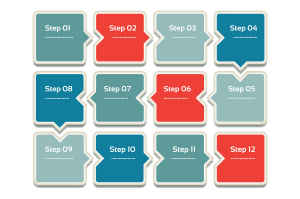If you’re a brand new store owner or even a seasoned veteran, your daily goal is to keep the lights on and product shipping. With so many other more pressing issues on your mind, it’s easy to defer sales tax to a later date. But taking a few minutes to make sure your ducks are in a row will end up saving you a lot of time and money.
Sales tax varies from state to state and is always changing, so it’s important to make sure you’re following the current rules and regulations for all the states where you have sales tax nexus. This guide will give you everything you need for an annual checkup.
The Importance of Sales Tax Compliance
As I mentioned earlier, most store owners know they’ll need to deal with state sales tax at some point, but with so many other things to do to get their ecommerce site started, tax compliance is sometimes delayed until the store is generating revenue and there is more time to deal with “overhead.”
Well, we’re here with good news. While sales tax may seem overwhelming, getting started is the hardest part. Taking time to get set up now will help you avoid common mistakes and pitfalls later, like:
- Collecting the wrong amount of sales tax—Not collecting enough can leave you paying the state out of pocket. Collecting too much can mean unhappy customers!
- Collecting without a permit—Many states consider it unlawful to collect without a permit, even if your intentions were good
- Not keeping up with changing sales tax rates and laws—Sales tax is ever-changing. Fortunately, there are ways to “set it and forget it.”
I know sales tax can seem overwhelming. Keep reading for the best way to give your store a sales tax check-up!
Why is Sales Tax Compliance Difficult?
Facing sales tax compliance in multiple states is often overwhelming to most people without accounting degrees due to the large amount of variables involved. Let’s take a look at a few:
- Some items are taxable and some are not. Most items sold in the United States are subject to sales tax but not all. In some states, clothing is not taxed while other states charge a lower sales tax rate on groceries (or no tax at all).
- Sales tax compliance is governed at the state level. Each of the 45 states (plus D.C.) that have a sales tax have rules and regulations that are always slightly different. Some states have origin-based sales tax while others use destination-based, and some states require you to charge sales tax on shipping.
- Tax rates and due dates vary by state. Some states have a single flat sales tax rate, but most states require you to collect taxes that vary from one municipality to the next. Unlike federal income tax, each state may have a different sales tax due date to consider. Some states want monthly returns, others demand quarterly, and even some others may only want you to file annual returns. Usually this is based on your sales volume, but sometimes it’s just that state’s preference.
Five Steps to Give Your Store a Sales Tax Compliance Check-up
Fortunately, it’s not difficult to give your business an annual check-up to make sure that you’re compliant for all of the states where you should be submitting sales tax returns. Here are five steps for evaluating your business’ sales tax practices:
1. Double-check your sales tax nexus
It’s great when your business grows, but that can often mean engaging in ecommerce activities that might cause you to create nexus in a new state. In the past year, have you:
* Opened a new physical location or stored goods in a warehouse?
* Hired an employee, contractor, or salesperson who physically works in another state?
* Used third-party affiliates to send sales to your store?
* Travelled to another state to sell products at a trade show or craft fair?
* Created a drop-shipping relationship with a third party?
If any of these activities sound familiar, you may have created nexus in a new state.
2. Review your sales tax permits
You may have just realized that you have nexus in a new state. If so, make sure that you register for your sales tax permit in that state.
It’s also possible you may no longer have nexus in a state. Maybe your remote employee left the company or you decided to stop going to the big craft show three states away. If that’s the case, contact your state’s taxing authority to cancel any sales tax permits you no longer need. Keep in mind that some states may consider you to have nexus for a few months (or longer) after your nexus-creating activity in that state has ended. It’s called “trailing nexus.” Check with your state to make sure you don’t have trailing nexus before filing your last return with that state.
3. Review or change your filing frequency
Many states will start you out filing monthly for the first year you’ve registered for your sales tax permit but then might change you to a quarterly or annual filing frequency. This is especially prevalent in the southeast. This is a good time to make sure you’ve checked all communications from your state’s taxing authority to determine if your filing frequency has been changed.
Also keep in mind that some states will allow you to change your filing frequency if asked. Arizona, for example, will often put you on a monthly filing frequency at first but will change you to a quarterly or annual frequency if you ask nicely. One call or email could save you a lot of work, so it definitely pays to contact your state taxing authority to check.
4. Check for changes to sales tax rates
You should keep in mind that state and local sales taxes are always subject to change at any time, which means you’ll also need to update the rates of your store. Most rate changes happen either at the first of the year, July, or October. You can always double-check a sales tax rate by entering the ZIP code into TaxJar’s Sales Tax Calculator.
5. Make sure you’re collecting on all channels
One of the biggest mistakes we see at TaxJar is forgetting to collect sales tax on all channels for that state. If you have nexus in a state because you hired someone to help you with customer service for your Shopify store but your business also sells through Amazon or eBay, make sure you’re collecting sales tax on all three of those platforms. The same goes for when you no longer have sales tax nexus in a state—make sure you stop collecting from buyers in that state on all channels.
And that’s it! If you’ve made it this far, give yourself a lollipop for passing the check-up.
Sales tax is complex, I get it. Even experienced store owners need a helping hand from time to time and brand new sellers are probably still considering the implications of becoming fully tax compliant.
Hopefully, this check-up will help prepare you for bigger and better things in the new year!
Business & Finance Articles on Business 2 Community(18)



